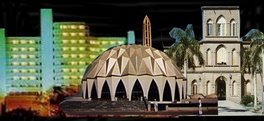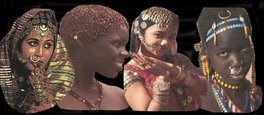first government and the First Civil War
- and
-
In February 1953, the United Kingdom and Egypt concluded an agreement providing for Sudanese self-government and self-determination. The transitional period toward independence began with the inauguration of the first parliament in 1954. With the consent of the British and Egyptian Governments, Sudan achieved independence on 1 January 1956, under a provisional constitution. The United States was among the first foreign powers to recognize the new state. However, the Arab-led Khartoum government reneged on promises to southerners to create a federal system, which led to a mutiny by southern army officers that sparked 17 years of civil war (1955-1972). In the early period of the war, hundreds of northern bureaucrats, teachers, and other officials, serving in the south were massacred.
The National Unionist Party (NUP), under Prime Minister Ismail al-Azhari, dominated the first cabinet, which was soon replaced by a coalition of conservative political forces. In 1958, following a period of economic difficulties and political maneuvering that paralyzed public administration, Chief of Staff Lt. Gen. Ibrahim Abboud overthrew the parliamentary regime in a bloodless coup.
Gen. Abboud did not carry out his promises to return Sudan to civilian government, however, and popular resentment against army rule led to a wave of riots and strikes in late October 1964 that forced the military to relinquish power.
The Abboud regime was followed by a provisional government until parliamentary elections in April 1965 led to a coalition government of the Umma and National Unionist Parties under Prime Minister Muhammad Ahmad Mahjoub. Between 1966 and 1969, Sudan had a series of governments that proved unable either to agree on a permanent constitution or to cope with problems of factionalism, economic stagnation, and ethnic dissidence. The succession of early post-independence governments were dominated by Arab Muslims who viewed Sudan as a Muslim Arab state. Indeed, the Umma/NUP proposed 1968 constitution was arguably Sudan’s first Islamic-oriented
The Nimeiry Era
-
Dissatisfaction culminated in a second military coup on 25 May 1969. The coup leader, Col. Gaafar Nimeiry, became prime minister, and the new regime abolished parliament and outlawed all political parties.
Disputes between Marxist and non-Marxist elements within the ruling military coalition resulted in a briefly successful coup in July 1971, led by the Sudanese Communist Party. Several days later, anti-communist military elements restored Nimeiry to power.
In 1972, the Addis Ababa Agreement led to a cessation of the north-south civil war and a degree of self-rule. This led to ten years hiatus in the civil war.
Until the early 1970s Sudan's agricultural output was mostly dedicated to internal consumption. In 1972 the Sudanese government became more pro-Western, and made plans to export food and cash crops. However, commodity prices declined throughout the 1970s causing economic problems for Sudan. At the same time, debt servicing costs, from the money spent mechanizing agriculture, rose. In 1978 the IMF negotiated a Structural Adjustment Program with the government. This further promoted the mechanized export agriculture sector. This caused great economic problems for the pastoralists of Sudan (See Nuba Peoples).
In 1976, the Ansars mounted a bloody but unsuccessful coup attempt. In July 1977, President Nimeiry met with Ansar leader Sadiq al-Mahdi, opening the way for reconciliation। Hundreds of political prisoners were released, and in August a general amnesty was announced for all opponents of Nimeiry’s government.
Arms suppliers
Sudan relied on a variety of countries for its arms supplies. Since independence the army had been trained and supplied by the British, but relations were cut off after the Arab-Israel Six-Day War in 1967. At this time relations with the USA and West Germany were also cut off.
From 1968-1972 the Soviet Union and eastern bloc nations sold large numbers of weapons and provided technical assistance and training to Sudan. At this time the army grew from a strength of 18,000 to roughly 50,000 men. Large numbers of tanks, aircraft, and artillery were acquired at this time, and they dominated the army until the late 1980s.
Relations cooled between the two sides after the coup in 1972, and the Khartoum government sought to diversify its suppliers. The USSR continued to supply weapons until 1977, when their support of Marxist elements in Ethiopia angered the Sudanese sufficiently to cancel their deals. China was the main supplier in the late 1970s.
Egypt was the most important military partner in the 1970s, providing missiles, personnel carriers, and other military hardware. At the same time military cooperation between the two countries was important.
Western countries began supplying Sudan again in the mid 1970s. The United States began selling Sudan a great deal of equipments around 1976, hoping to counteract Soviet support of Marxist Ethiopians and Libyans. Military sales peaked in 1982 at US$101 million. After the start of the second civil war, American assistance dropped, and was eventually all but cancelled in १९८७
Second Civil War
-
In 1983 the civil war was reignited following the government's Islamicization policy which would have instituted Islamic law, among other things. After several years of fighting, the government compromised with southern groups.
-
On April 6, 1985, a group of military officers, led by Lieutenant General Abd ar Rahman Siwar adh Dhahab, overthrew Nimeiri, who took refuge in Egypt. Three days later, Dhahab authorized the creation of a fifteen-man Transitional Military Council (TMC) to rule Sudan.
-
In June 1986, Sadiq al Mahdi formed a coalition government with the Umma, the DUP, the NIF, and four southern parties. Unfortunately, however, Sadiq proved to be a weak leader and incapable of governing Sudan. Party factionalism, corruption, personal rivalries, scandals, and political instability characterized the Sadiq regime. After less than a year in office, Sadiq al Mahdi dismissed the government because it had failed to draft a new penal code to replace the sharia, reach an agreement with the IMF, end the civil war in the south, or devise a scheme to attract remittances from Sudanese expatriates. To retain the support of the DUP and the southern political parties, Sadiq formed another ineffective coalition government.
In 1989 it appeared the war would end, but a coup brought a military junta into power which was not interested in compromise. Since that time the war raged across Sudan.
The civil war has displaced more than 4 million southerners. Some fled into southern cities, such as Juba; others trekked as far north as Khartoum and even into Ethiopia, Kenya, Uganda, Egypt, and other neighboring countries. These people were unable to grow food or earn money to feed themselves, and malnutrition and starvation became widespread. The lack of investment in the south resulted as well in what international humanitarian organizations call a “lost generation” who lack educational opportunities, access to basic health care services, and little prospects for productive employment in the small and weak economies of the south or the north.
Peace talks between the southern rebels and the government made substantial progress in 2003 and early 2004, although skirmishes in parts of the south have reportedly continued. The two sides have agreed that, following a final peace treaty, southern Sudan will enjoy autonomy for six years, and after the expiration of that period, the people of southern Sudan will be able to vote in a referendum on independence. Furthermore, oil revenues will be divided equally between the government and rebels during the six-year interim period. The ability or willingness of the government to fulfill these promises has been questioned by some observers, however, and the status of three central and eastern provinces was a point of contention in the negotiations. Some observers wondered whether hard line elements in the north would allow the treaty to proceed.
A final peace treaty was signed on 9 January 2005 in Nairobi. The terms of the peace treaty are as follows:
- The south will have autonomy for six years, followed by a referendum on secession.
- Both sides of the conflict will merge their armed forces into a 39,000-strong force after six years, if the secession referendum should turn out negative.
- Income from oilfields is to be shared 50 to 50.
- Jobs are to be split according to varying ratios (central administration: 70 to 30, Abyei/Blue Nile State/Nuba mountains: 55 to 45, both in favour of the government).
- Islamic law is to remain in the north, while continued use of the sharia in the south is to be decided by the elected assembly



